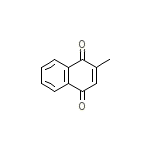2-Methyl-1,4-naphthoquinone




2-Methyl-1,4-naphthoquinone Brand names, 2-Methyl-1,4-naphthoquinone Analogs
2-Methyl-1,4-naphthoquinone Brand Names Mixture
- No information avaliable
2-Methyl-1,4-naphthoquinone Chemical_Formula
C11H8O2
2-Methyl-1,4-naphthoquinone RX_link
No information avaliable
2-Methyl-1,4-naphthoquinone fda sheet
2-Methyl-1,4-naphthoquinone msds (material safety sheet)
2-Methyl-1,4-naphthoquinone Synthesis Reference
No information avaliable
2-Methyl-1,4-naphthoquinone Molecular Weight
172.183 g/mol
2-Methyl-1,4-naphthoquinone Melting Point
102 oC
2-Methyl-1,4-naphthoquinone H2O Solubility
Insoluble
2-Methyl-1,4-naphthoquinone State
Solid
2-Methyl-1,4-naphthoquinone LogP
1.758
2-Methyl-1,4-naphthoquinone Dosage Forms
Tablets (5mg) and injection (5, 10, 37.5 mg/ml)
2-Methyl-1,4-naphthoquinone Indication
The primary known function of vitamin K is to assist in the normal clotting of blood, but it may also play a role in normal bone calcification.
2-Methyl-1,4-naphthoquinone Pharmacology
Menadione is a fat-soluble vitamin precursor that is converted into menaquinone in the liver. Vitamin K1 and K2 are the naturally occurring types of vitamin K. The former, which is also known as phylloquinone, is synthesized by plants and can be found in such foods as spinach, broccoli, lettuce, and soybeans. The latter, sometimes alternatively referred to as menaquinone, is primarily produced by bacteria in the anterior part of the gut and the intestines. Vitamin K3, on the other hand, is one of the many manmade versions of vitamin K. Also called menadione, this yellowish, synthetic crystalline substance is converted into the active form of the K2 vitamin inside of the animal body. While a vitamin K deficiency can be dangerous, especially to infants that may easily suffer from extensive hemorrhaging, an overdose can be as equally detrimental. Newborns that are administered too great a dosage of vitamin K3 can suffer from kernicterus, a form of severe brain damage that may produce decreased movement, loss of appetite, seizures, deafness, mental retardation, and even death. This condition is associated with an abnormally high concentration of bilirubin, a bile pigment, in the tissues of the brain, which can be caused by the presence of K3. For this reason, K3 is less often utilized medically than it was in former times.
2-Methyl-1,4-naphthoquinone Absorption
Variable and ranges from 10% to 80%
2-Methyl-1,4-naphthoquinone side effects and Toxicity
Menadione (vitamin K3), which is not used as a nutritional supplemental form of vitamin K for humans, has been reported to cause adverse reactions, including hemolytic anemia. Large doses have also been reported to cause brain damage.
2-Methyl-1,4-naphthoquinone Patient Information
No information avaliable
2-Methyl-1,4-naphthoquinone Organisms Affected
Humans and other mammals














